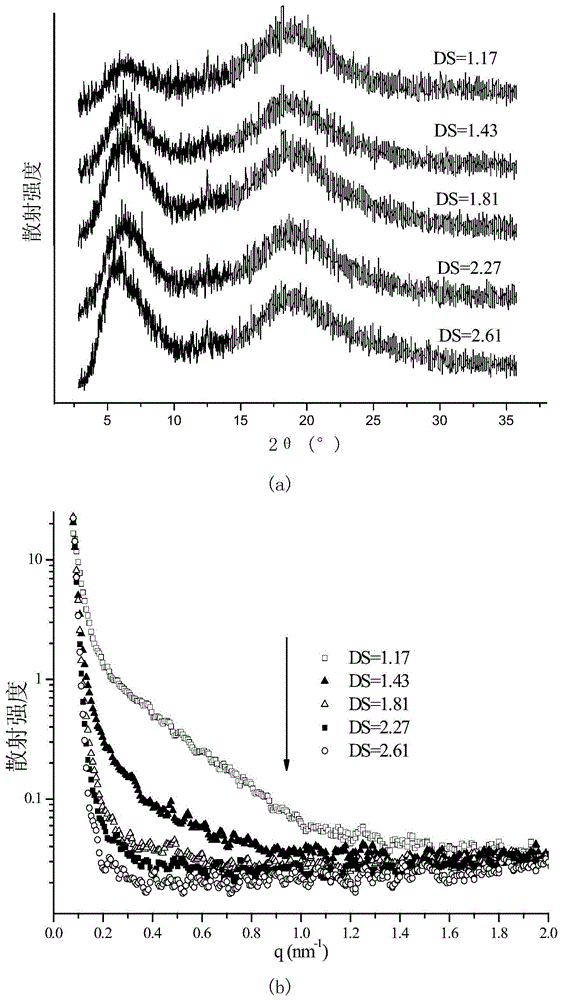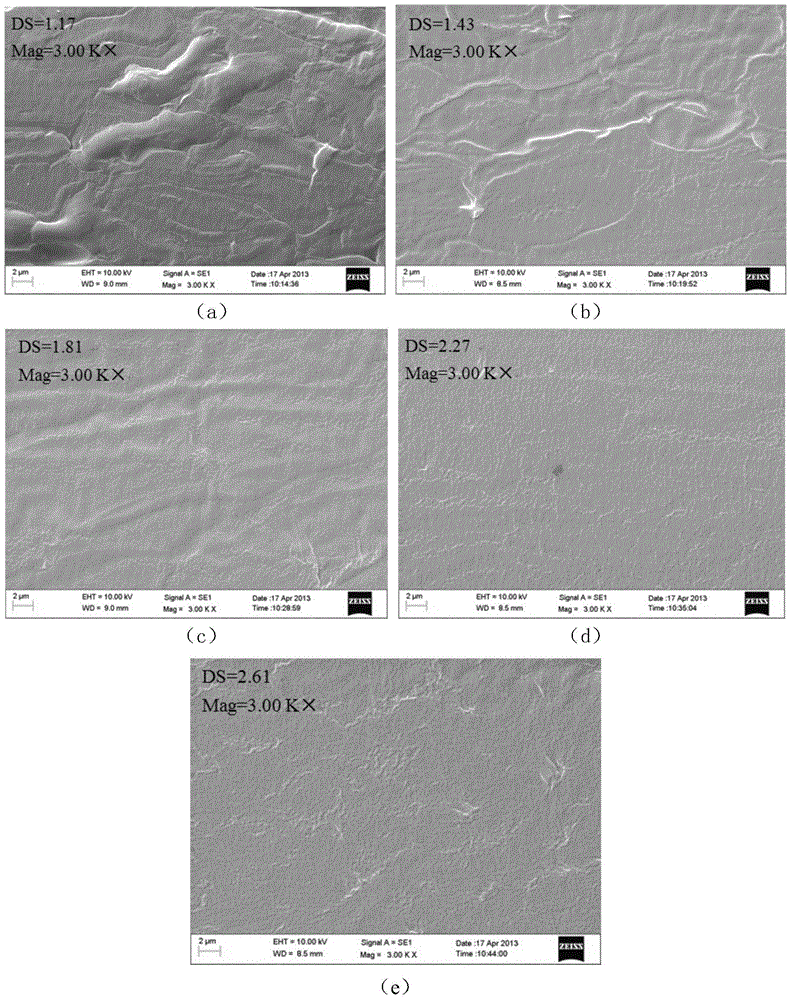A method for inhibiting migration of plasticizer in esterified starch film and esterified starch film
A technology of esterified starch and plasticizer, which is applied in the field of inhibition of plasticizer in esterified starch-based biodegradable packaging materials, can solve the problems of neglecting the regulation of interaction of polymer materials, and achieves good use effect and operation. Strong and wide application effect
- Summary
- Abstract
- Description
- Claims
- Application Information
AI Technical Summary
Problems solved by technology
Method used
Image
Examples
Embodiment 1
[0021] A method for suppressing plasticizer migration in esterified starch films, carried out through the following steps:
[0022] (1) Add starch milk with a water content of 40% into a high-temperature and high-pressure reactor, control the pH of the system to 9, then add 2ml / g of acetic anhydride (calculated on a dry basis of starch) and stir for 0.5h at a temperature of 80°C. After the reaction is completed, add water to precipitate, filter, and dry to obtain acetate-esterified starch with a substitution degree of 1.17.
[0023] (2) dissolving the acetate-esterified starch obtained in step (1) in acetone to form a solution with a mass percentage concentration of 4%, adding plasticizer diethyl phthalate 20% (w / w, in the form of ester Starch dry basis) using a fluidized bed at 50 ° C, with a spray rate of 1.0mL / min and an atomization pressure of 1.0 MPa, it is sprayed into a translucent film on a polytetrafluoroethylene plate to obtain an esterified starch film (such as figu...
Embodiment 2
[0025] A method for suppressing plasticizer migration in esterified starch films, carried out through the following steps:
[0026] (1) Add starch milk with a water content of 70% into a high-temperature and high-pressure reactor, control the pH of the system to 10.5, then add 3ml / g of propionic anhydride (based on starch dry basis) and stir for 0.5h at a temperature of 90°C. After the reaction is completed, add water to precipitate, filter, and dry to obtain acetate-esterified starch with a substitution degree of 1.43.
[0027] (2) dissolving the acetate-esterified starch obtained in step (1) in acetone to form a solution with a mass percentage concentration of 4%, adding plasticizer diethyl phthalate 20% (w / w, in the form of ester Starch dry basis) Utilize fluidized bed at 52 ℃, with spraying rate 2.0mL / min, atomization pressure is 0.5MPa to spray on polytetrafluoroethylene board into translucent film, promptly obtains esterified starch film (such as figure 2 shown).
Embodiment 3
[0029] A method for suppressing plasticizer migration in esterified starch films, carried out through the following steps:
[0030] (1) Add starch milk with a water content of 60% into a high-temperature and high-pressure reaction kettle, control the pH of the system to 10.5, then add 3ml / g of propionic anhydride (based on starch dry basis) and stir at a temperature of 90°C for 1.5h, After the reaction is completed, add water to precipitate, filter, and dry to obtain acetate-esterified starch with a substitution degree of 1.81.
[0031] (2) dissolving the acetate-esterified starch obtained in step (1) in acetone to form a solution with a mass percentage concentration of 4%, adding plasticizer diethyl phthalate 20% (w / w, in the form of ester Starch dry basis) Utilize fluidized bed at 50 ℃, with spray rate 1.0mL / min, atomization pressure is 1.2MPa to spray on polytetrafluoroethylene board into translucent film, promptly obtains esterified starch film (such as figure 2 shown). ...
PUM
| Property | Measurement | Unit |
|---|---|---|
| degree of substitution | aaaaa | aaaaa |
Abstract
Description
Claims
Application Information
 Login to View More
Login to View More - R&D
- Intellectual Property
- Life Sciences
- Materials
- Tech Scout
- Unparalleled Data Quality
- Higher Quality Content
- 60% Fewer Hallucinations
Browse by: Latest US Patents, China's latest patents, Technical Efficacy Thesaurus, Application Domain, Technology Topic, Popular Technical Reports.
© 2025 PatSnap. All rights reserved.Legal|Privacy policy|Modern Slavery Act Transparency Statement|Sitemap|About US| Contact US: help@patsnap.com



